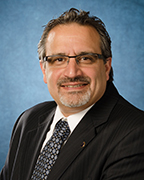Page Content
Educational leadership
 The Oxford Dictionary defines the school principal as “The head of a school, college, or other educational institution.” But if you take out the word school, the definition of principal is, “First in order of importance.” The first definition is one of position, a managerial position, whereas the second is one of leadership. This is the constant paradox and dilemma for principals—management vs leadership. While we aspire to the latter, the unfortunate truth is many principals spend an inordinate amount of time doing the former.
The Oxford Dictionary defines the school principal as “The head of a school, college, or other educational institution.” But if you take out the word school, the definition of principal is, “First in order of importance.” The first definition is one of position, a managerial position, whereas the second is one of leadership. This is the constant paradox and dilemma for principals—management vs leadership. While we aspire to the latter, the unfortunate truth is many principals spend an inordinate amount of time doing the former.
As we look at this edition of the ATA Magazine, it is clear that the role of the administrator has dramatically changed over the last few years and has become increasingly complex and more important. As our education system struggles with changes to curriculum and pedagogy, it is easy for school administrators to become bogged down with the minutiae of their daily work. At the same time as they are overloaded with detail work, they are expected to be innovative change agents for their students and faculty. No wonder, then, that this issue speaks to the magic of principals’ work.
Add to this the demographic reality that, as the baby boomer generation moves through the profession, more and more experienced administrators are reaching retirement age. While this can be seen as an opportunity for new and fresh ideas, it also means that collectively we are losing a huge pool of what is often referred to as “corporate memory”. To further complicate matters, assistant principals and teachers are expressing less and less interest in moving into the principal role.
Leadership, especially educational leadership, has been defined by some as an art. You can’t really define what it is, but you can define practices that are common to exemplary leadership. In 2002, Kouzes and Posner wrote that there are five practices that are common among the best education leaders. They posited that the best leaders model the way, inspire a vision, challenge the process, enable others to act and encourage the heart.
A lot has been said in the media lately about the myriad of things that the Task Force for Teaching Excellence got wrong, and one of those is the recommendation titled “Empowering Principals”. This recommendation proposes that principals be empowered in human resource functions, and if this empowerment cannot be realized within the current structure, then consideration needs to be given to remove principals from the Association.
As president of the Association I spend a great deal of time talking with teachers and administrators, and I hear one message repeatedly: “We need more support.” They need support to become the best educational leaders they can be. They need support to model what great teaching and learning looks like. They need support to implement many of the ideas articulated in Inspiring Education. They need support to try new things and to challenge old assumptions. They need support so that they have time to reflect on their teaching in order to grow as professionals. As educators, we need to come together to learn from each other, but at the same time we need to acknowledge that every school is different and needs to find its own way. Changing the culture of a school, a district or a province is not an easy task. But if the culture does not change, then nothing really changes. What I did not hear was that principals need more authority in human resource functions.
We are extremely lucky in Alberta that our model of principals being the lead or first teacher results in a collegial relationship. In the vast majority of schools this relationship works to ensure that high quality teaching occurs on a daily basis. Principals work with their teachers on their personal professional growth plans. These documents must be informed by school and district growth plans and are reviewed at least once a year. During that review process the principal may raise, in a collegial and confidential manner, any potential concerns, and both parties can then discuss possible areas for growth.
Because of this relationship, teachers who are struggling in a particular area feel free to ask their principals for help and support. They can tailor their growth plans to reflect their needs. Over the course of the year principals may be asked to observe their classes specifically looking for proof of growth and providing valuable feedback about how to improve even more. Because the growth plan is just that, a plan for growth and not an evaluative tool, teacher and principal can work together to ensure excellence. Imagine if the principal, instead of being a member of a team of professionals, was the manager. Would teachers feel safe in confiding in their manager that they needed help in developing their skills?
Principals are much more than managers; they are educational leaders. But many principals will tell you that they spend an inordinate amount of time on management duties. Adding a strict and top-down evaluation process when they are already engaged in ongoing supervision and in evaluation as required will add one more managerial function for our principals. How does this in any way contribute to great educational leadership? I became a teacher because I wanted to teach. I became an administrator because I wanted to show educational leadership. I wanted to model the way, inspire a vision, challenge the process, enable others to act and encourage the heart.
